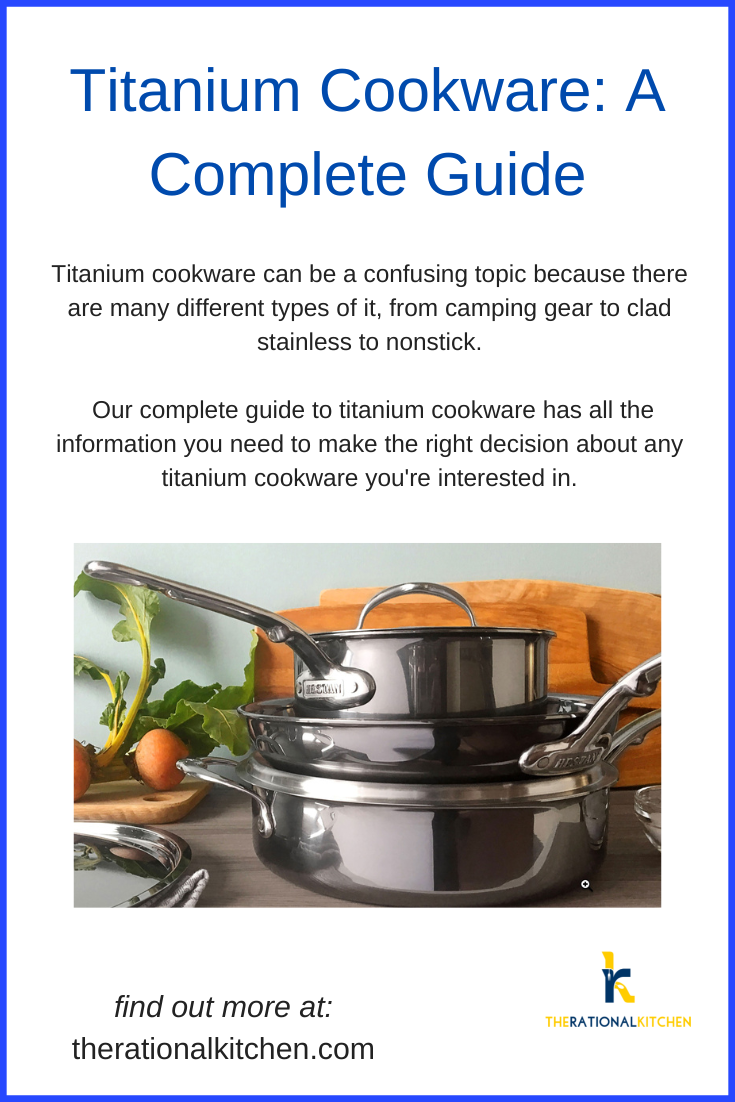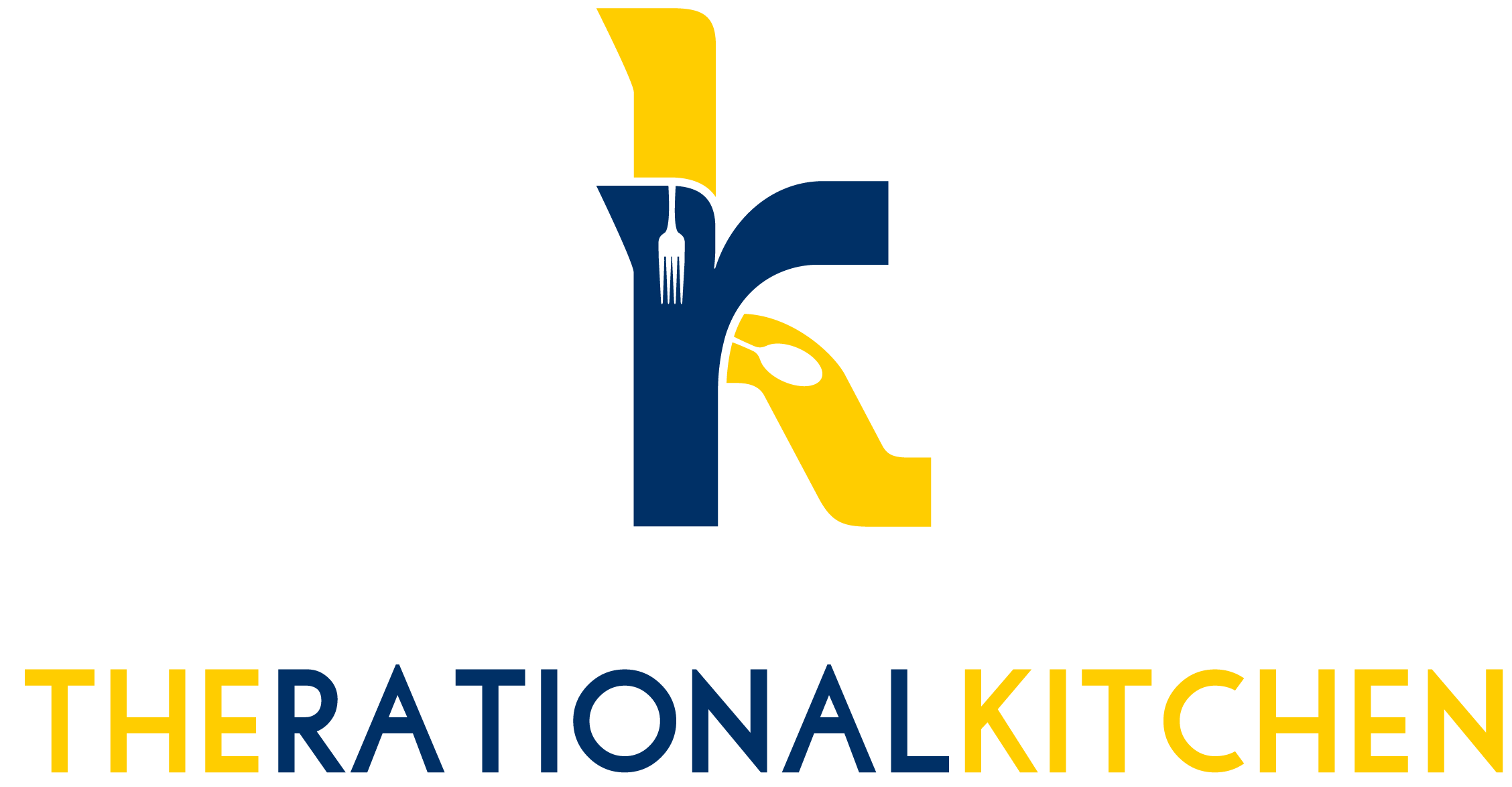There's been a lot of buzz about titanium cookware in recent years. But what exactly IS titanium cookware? And why can it be so confusing and hard to figure out?
It turns out that "titanium" can mean several things, especially when it comes to nonstick cookware. If you don't understand all the meanings and how the word is used by the cookware maker, you might end up with the wrong cookware.
We researched all the different titanium cookware. If you have questions about titanium cookware, you should find the answers here.
What Is Titanium?
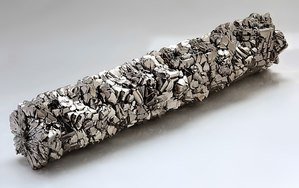
Titanium is a moderately rare metal prized for three characteristics: lightness, non-reactivity, and strength. It's as strong as steel but half the weight, and is often used as an alloy with other metals such as aluminum and iron to increase durability while decreasing weight.
You can find titanium and titanium alloys in many products, including aircraft, camping equipment, bicycles, drill bits, golf clubs, and more. Titanium is rare and costly, so most products containing significant amounts of titanium are expensive.
Probably because of its association with the aircraft industry and other high-tech applications, titanium has become synonymous with high quality, modern, cutting edge, and advanced. But to understand if this is true or just marketing jargon--especially for cookware--you have to dig a little deeper.
You can read more about titanium on Wikipedia.
Titanium in Cookware
Titanium has become a marketing buzzword in the cookware industry. You might think that with titanium's lightness, non-reactivity, and strength, it would be a huge plus in any cookware. But this isn't necessarily true.
Here's why.
Cost. First of all, titanium is expensive, so any significant amount of it is going to raise the cost of a product. For nonstick pans in particular, this isn't a good idea, because nonstick coatings have such a short life span, and there's no definitive evidence that titanium increases it. (Note: if "titanium" nonstick cookware is cheap, it probably contains very little titanium.)
For clad cookware with a titanium cooking surface, you should have a specific reason for buying it, such as a nickel allergy.
Heating. Second, titanium has terrible heating properties. It heats slowly and unevenly, and it hangs onto heat poorly. By itself, titanium makes pretty awful cookware unless your primary goal is lightness, as it is for camping. To put this in perspective, titanium has a thermal conductivity of 17 W/mK (watts per meter kelvin, a unit of thermal conductivity). This is similar to stainless steel (15 W/mK). For comparison, aluminum has a thermal conductivity of 237 W/mK and copper's is 401 W/mK.
Nonstick properties. Third, and contrary to marketing jargon you may have heard or read, titanium has no nonstick properties of any kind. In fact, titanium behaves much like stainless steel: food sticks to it and can be hard to clean if you don't use the right cooking techniques.
Despite its drawbacks, titanium cookware is getting more popular. We'll look at all the different types of titanium (and "titanium") cookware and discuss the pros and cons of each.
Types of Titanium Cookware
"Titanium cookware" can mean several things (click on the links to see examples on Amazon):
- Camping cookware--prized for its lightness, but not good for daily cookware because of its poor heating properties.
- Clad cookware with an actual titanium cooking surface.
- Clad stainless cookware with a titanium-reinforced stainless steel cooking surface (316Ti rather than the more common 304 grade): contains a very small amount of titanium, about 0.5%.
- Clad stainless cookware with a patented titanium nanobond coating.
- Nonstick cookware with a titanium reinforced cooking surface--and here, and here, and here--includes PTFE and ceramic titanium
- Titanium nonstick cooking surface such as on the Viking Performance Ti and the Our Place Titanium Pro pan with nonstick titanium cooking surface ("NoCo", not a nonstick coating)
- Titanium is the color of the cookware (and it contains no titanium).
We'll take a look at each of these in detail to see what the term "titanium" really means in each category.
Titanium Camping Cookware (100% Titanium)
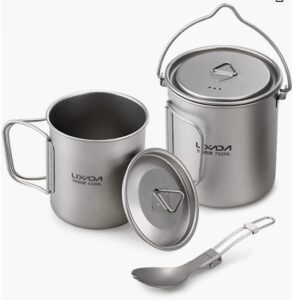
Prices vary by size of set--this set of 3 pieces (plus lids) is about $50
Camping and backpacking cookware is the only 100% titanium cookware on the market. This is because titanium is light, so it's good for hauling in a backpack.
Titanium camping cookware is not intended for kitchen use and would not make good daily cookware because of its poor heating properties. It is also sticky like stainless steel, so by itself has no nonstick properties.
Stainless Cookware with Titanium Cooking Surface
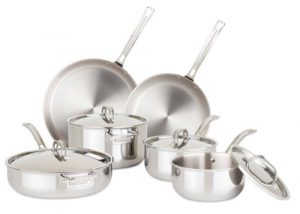
Viking 7-Ply Titanium cookware (about $1500 for 10 piece set)
Viking PerformanceTi cookware (about $1500 for 12 piece set)
We know of only two lines of clad stainless steel cookware with a titanium cooking surface, and they're both made by Viking: Viking 7-Ply Titanium Cookware and their new PerformanceTi 4-ply cookware.
The 7-Ply Titanium cookware has an external layer of magnetic stainless for induction compatibility, 5 internal layers of aluminum heating core, and a cooking surface of 100% titanium.
The PerformanceTi cookware has a magnetic stainless exterior, an aluminum heating core, and a titanium interior with a laser-etched titanium nonstick cooking surface that's free of chemicals and toxins. We're not sure what else is in the laser-applied titanium nonstick cooking surface, but if it's nonstick, then it's probably not 100% titanium.
A titanium cooking surface has pros and cons. On the pro side, it's stable and non-reactive and won't leach nickel or chromium, as stainless steel does in tiny amounts. Viking says titanium has a natural bacteria inhibitor as well, but we haven't been able to verify that this is the case.
On the con side, titanium is a terrible heat conductor--thus the aluminum heating core--it sticks as bad or worse than stainless steel, and it's expensive.
If you have a nickel allergy or are concerned about nickel and chromium leaching from standard stainless steel cookware, this may be a good choice for you (but the amounts of leaching from stainless steel are small and not considered unsafe).
See our Viking Cookware Review for more information about this cookware.
Titanium Reinforced Clad Stainless Steel Cookware (316Ti)
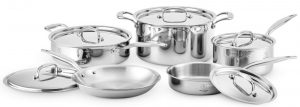
About $800 for 10 piece set
In clad stainless steel cookware, titanium-reinforced steel--called 316Ti--is considered by some people to be higher quality than standard 304 grade steel.
Though there may be more, we know of just two cookware brands that use 316Ti stainless steel: Heritage Steel (see our Heritage Steel review) and Saladmaster (see our Saladmaster review). Saladmaster fans in particular love to say that Saladmaster is "titanium" cookware, but it is actually made with 316Ti steel. 316Ti is a stainless steel alloy that contains a small amount of titanium.
The percentage of titanium in 316Ti? About 0.7%.
Saladmaster enthusiasts in particular like to think their cookware doesn't leach any nickel or chromium (because it's "titanium"), but this is not the case. 316Ti leaches about the same amounts of nickel and chromium as 304 steel. (And we repeat here: the amounts leached are extremely small and not considered a health or safety issue: our bodies need trace amounts of both nickel and chromium, so these are not unsafe substances.)
316Ti is a great alloy for cookware, and we recommend Heritage Steel as a high quality, USA-made brand of cookware. But it is nowhere near pure titanium (neither is Saladmaster), and it is equally reactive as 304, with a small increase in durability.
Titanium-Nanobond Coated Stainless Steel Cookware (Not Nonstick)
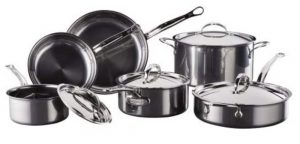
About $1700 for 10 piece set
Hestan NanoBond stainless cookware has a patented titanium nanobond coating which adds durability and provides a stable, non-reactive cooking surface.
The titanium adds something, but even so, it's a thin layer mixed with other materials, so the amount of actual titanium is unknown. The titanium is part of what we think is a type of physical vapor deposition (PVD), a process by which extremely thin layers of materials are applied to an object in a vacuum to increase hardness, among other things.
PVD is seen mostly in industrial applications used to strengthen parts. Hestan NanoBond is the only cookware we know of that has such a coating.
Hestan has several patents on their titanium nanobond coating, but it's difficult to say how much value it adds to the cookware. We do know that it's safe and stable, and a good choice if you're looking for something that won't leach any chemicals into your food or are looking for premium cookware that doesn't contain nickel.
We should also say that this is a completely different material than ceramic nonstick coatings (discussed in more detail below). Hestan NanoBond is not a nonstick coating, it is not a sol-gel, and it has none of the issues associated with nonstick coatings (e.g., titanium dioxide nanoparticles).
See our Hestan Cookware Review for more information, including details about the nanobond coating.
Nonstick "Titanium" Cookware (PTFE and Ceramic)
These are standard nonstick coatings that have titanium particles added to them.
Before we dive any deeper into nonstick cookware, you should know that there are two kinds--and only two kinds--of nonstick cookware: PTFE and ceramic nonstick. PTFE has been around since the 1950s, and ceramic nonstick was invented in 2007. We include this so you know that any nonstick cookware that's called "granite," "diamond," "titanium," or something else is either PTFE or ceramic nonstick. There is no such thing as granite, diamond, or titanium nonstick cookware that does not also contain a PTFE or ceramic nonstick coating.
(If you aren't familiar with the two types of nonstick cookware, we recommend reading our articles What Is PFOA? A Guide to Nonstick Cookware Chemicals and Is Nonstick Cookware Safe? as well as several product reviews you can find on our Cookware page.)
Titanium and other materials are added to both types of nonstick cookware for durability. Durability is the holy grail of nonstick cookware. This is why you see so many brands of nonstick cookware with words like granite, stone, rock, diamond, and titanium in the name (true for both PTFE and ceramic nonstick brands): promises of durability is what sells nonstick cookware (and none of them last more than a few years).
Here's a diagram of a titanium nonstick coating. The titanium (or granite, diamond, etc.) protrudes above the coating and protects it:

Does titanium improve the durability of nonstick cookware? If it does, it's by a small margin. Our research has found very little difference in longevity between regular nonstick cookware and reinforced nonstick cookware.
PTFE Titanium Nonstick Cookware
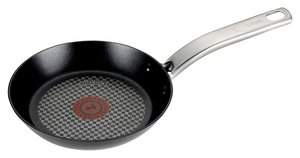
T-fal ProGrade Titanium skillet (about $35)
Saflon Titanium Cookware (about $230 for 10 piece set)
Titanium Cookware (about $400 for a 12-inch skillet)
Many brands of PTFE nonstick cookware are reinforced with titanium. Makers add a small amount of titanium to the coating to make it more durable; they may also do this so they can call the cookware "titanium"--or granite, diamond, rock, etc.--rather than what it really is, "PTFE."
As we said above, whether these substances actually improve the durability and longevity of the nonstick coating is questionable, as pretty much all nonstick cookware has a life span of 1-5 years regardless of what it's reinforced with.
Ceramic Titanium Nonstick Cookware
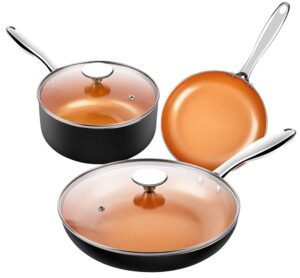
Michelangelo (about $45 for 12-in. skillet with lid, about $56 for 5 piece set shown above)
Gotham Steel (about $20 for a 10-in skillet)
Goodful (12 piece set about $130)
EuroCast by Berghoff (9 piece set about $800)
Zavor Noir (7 piece set about $230)
Ceramic nonstick cookware was invented in 2007. It has a completely different composition than traditional ceramics and enamels like those found in bakeware and on enameled cast iron cookware (which are not nonstick).
Ceramic nonstick cookware also has a completely different composition than PTFE nonstick cookware (i.e., Teflon): PTFE is made from hydrocarbons and is actually a type of plastic, while ceramic nonstick coatings are inorganic, made from silicon or clay.
But similar to PTFE, ceramic nonstick has a limited lifespan, and is known for losing its nonstick properties quickly; often even more quickly than PTFE. Thus, makers of ceramic nonstick began to add materials to increase durability, just as makers of PTFE cookware did.
One of the most popular of these is titanium.
Perhaps it's the confusing marketing, but ceramic-titanium nonstick cookware is some of the most misunderstood cookware on the market. People don't realize that ceramic-titanium nonstick is simply a ceramic nonstick coating with titanium added to it.
This gets confusing because there are so many different brands of ceramic nonstick coatings on the market, and a lot of marketing language about what the titanium actually does. But if you remember that all nonstick coatings are either PTFE or ceramic nonstick, you won't get as confused when reading about different nonstick brands.
As with PTFE coatings, it's uncertain how much durability titanium actually adds to the coating, because they all seem to have roughly the same life span of 1-5 years (reinforced or not). Once again, the amount of titanium added to the nonstick coating is probably small, because big amounts of titanium would raise the price.
Titanium Nonstick Pans with Real Titanium Coating
We know of two of these, but they use completely different technology: the Viking Performance Ti nonstick pan, and the Our Place Titanium Pro nonstick pan.
We really don't understand why cookware makers are using titanium for nonstick pans. As we've mentioned, titanium is not a nonstick material, so it seems like it's following in the marketing path of the PTFE and ceramic nonstick "titanium" cookware, which has also not been particularly successful. Buy at your own risk.
Viking Performance Ti Nonstick Pan
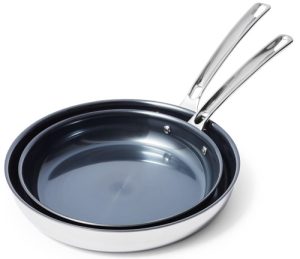
See the Viking Performance Ti pan on Amazon (about $400 for 2 skillets, 9.5/11")
This is a 4-ply pan with a stainless steel exterior, an aluminum heating core, a layer of titanium (why?), and a cooking surface of "laser applied" titanium. To achieve nonstick performance, you have to season the cooking surface like cast iron or carbon steel. Seasoning is tricky because the pan surface is so slick, as you can see in the picture. But when properly seasoned, this pan can be as nonstick as well seasoned carbon steel.
If you didn't notice, the price of two skillets is about $400, which is outrageous. With the hassle of seasoning and a result that's just okay nonstick, we're not sure who these pans are for or who would like them. Maybe appealing to people who don't want to life cast iron or carbon steel, as these pans are a bit lighter. They're well made, high quality, and attractive--they're just probably not worth the asking price unless you have an unlimited budget.
Our Place Titanium Pro Nonstick Pan

See Our Place Titanium Pro pan on Amazon (about $135 or $195 when not on sale)
See Our Place Titanium Pro pan with gold handle on Amazon (about $195)
See Our Place Titanium Pro pan at Our Place
The Our Place Titanium Pro nonstick pan has a new nonstick technology Our Place has patented as "NoCo," an acronym that means no coating. And it's true: it contains no nonstick coating of either type (PTFE or ceramic nonstick). Instead, it has a patterned hydrophobic cooking surface that repels water, which is supposed to make it nonstick like PTFE (which is one of the most hydrophobic materials known to man). It is a clad stainless steel pan with an external layer of steel, a heating core of aluminum, and a cooking surface that's titanium oxide (which is what titanium becomes when exposed to air).
We're not sure why they used titanium for the cooking surface, as it's not at all a nonstick material; it seems they could have accomplished the same thing with steel. But the titanium adds to the appeal of the pan and makes it sound like truly new technology.
We're not fans of the Always Pan. The design is just not great, with the huge spatula hole that makes it impossible to trap steam inside the pan, and the square handle--necessary for holding the spatula--is extremely uncomfortable and slippery. And as with ceramic nonstick, Hexclad, and other, um, innovative "nonstick" technologies, the instructions tell you it's necessary to use oil to achieve the nonstick properties. Which is exactly how you use stainless steel or any other type of cookware to make food not stick, so it's just kind of annoying that this is marketed as nonstick. But it's so common nowadays that people don't question the disingenuousness of this.
In any case, this pan truly has a titanium cooking surface, but that's not what makes it nonstick (or more accurately, "nonstick.")
Titanium as Marketing Jargon
Finally, cookware can be called "titanium" without actually containing any titanium. This Trisha Yearwood cookware set (looks discontinued) is named titanium after its color, a matte gray.
For all we know, dozens of other brands of "titanium" nonstick cookware might also be named for a color or style, and not because they contain any actual titanium.
By the way, this also goes for a lot of "copper" cookware, especially cheap nonstick "copper" cookware: it contains no actual copper, and is named for its color.
How to Buy Titanium Cookware

The titanium-nanobond coating makes Hestan NanoBond some of the safest, most stable cookware on the market.
Because titanium is a small addition to most types of cookware (except camping and backpacking cookware), you should instead look at how to buy the type of cookware you're interested in.
- If you want clad stainless steel with titanium, read about how to buy clad stainless steel cookware, then look at the Viking 7-Ply with a titanium cooking surface, the Hestan NanoBond with a titanium nanobond coating, or the Heritage Steel with a 316Ti cooking surface.
- If you want real titanium, Viking makes two lines of clad stainless with a titanium cooking surface: 7-Ply Titanium cookware and their new PerformanceTi 4-ply cookware.
- If you want titanium non-stick cookware, read about how to buy non-stick cookware (both PTFE and ceramic), then decide if a titanium (or "titanium") nonstick pan is the right choice.
There are only a few brands of stainless steel with titanium cookware. Heritage Steel has a 316Ti cooking surface, with less than 1% titanium. Hestan NanoBond, discussed above.
If you want camping or backpacking gear, we recommend finding another review site, as this is not our area of expertise.
Titanium Cookware FAQs
Here we answer some common questions about titanium cookware (nonstick and otherwise).
Is All Titanium Cookware Nonstick?
No, not at all. In fact, titanium itself is not a nonstick material. Titanium behaves much like stainless steel when cooking (that is, food sticks to it). Some nonstick coatings have small amounts of titanium added to them for durability, not for better nonstick properties.
Is Titanium Nonstick Cookware Safer to Use than Other Nonstick Cookware?
No. Adding titanium to nonstick coatings does not affect the safety of nonstick cookware. Titanium itself is stable and inert, so it's safe to cook with. But remember that it is a small part of any nonstick coating, so it won't alter a coating's safety level.
Any nonstick surface reinforced with titanium may last longer and take more abuse, but it's still going to have all the same properties of the nonstick coating, either PTFE (Teflon) or ceramic.
If you're concerned about safety, educate yourself on the two types of nonstick coatings, because whether they contain titanium or not, it's the coating composition that's going to determine the safety of the cookware.
Is Titanium Ceramic Cookware Safe?
Titanium ceramic pans are as safe as the ceramic nonstick coating, since the majority of the coating is the ceramic nonstick and the titanium is only a small addition to it.
Which is to say, probably--but there are a few issues with ceramic nonstick coatings. Titanium itself is a very stable, non-reactive material, so adding titanium to a ceramic coating does not affect its safety. However, there are some issues with ceramic nonstick coatings you should be aware of before you buy--such as titanium dioxide nanoparticles--and also, know that there isn't a lot of research available yet on ceramic nonstick coatings in general--so the safest answer here is that we don't know.
You can read more in our article Is Nonstick Cookware Safe?
Titanium Nonstick Vs. Teflon: Which Is Better?
There is no such thing as a titanium nonstick pan: it is either a PTFE or a ceramic nonstick coating with a tiny amount of titanium particles added to it to increase durability. "Teflon" is a brand name for PTFE, and it can have titanium in it, or other reinforcements such as granite or diamond dust.
Teflon (PTFE) reinforced with titanium is considered more durable, but in our testing, all Teflon non-stick pans had about the same longevity whether they had reinforcement materials or not.
What Is Titanium Coated Cookware?
There really is no such thing as "titanium coated cookware." Titanium is a metal, so if cookware has a titanium surface, it's clad, not coated.
There's some confusion about this because nonstick cookware is often referred to as "titanium" or even "titanium coated." However, these coatings are actually one of the two types of nonstick, either PTFE or ceramic nonstick, that have been reinforced with small amounts of titanium.
Thus, it's more accurate to call a nonstick coating "PTFE with titanium particles" or "ceramic nonstick with titanium particles."
Is Titanium Cookware Better than Clad Stainless Steel Cookware?
If we're talking pure titanium versus stainless steel, maybe, depending what you're looking for. Stainless steel is a safe, stable surface to cook with, but it does leach some small amounts of nickel and chromium--so if you have a nickel or chromium sensitivity, you may want titanium cookware (but it tends to be expensive).
As for nonstick pans, remember that we're dealing with either PTFE or ceramic nonstick, and there isn't enough titanium in them to have a large effect one way or the other--so whether you choose nonstick or reinforced nonstick doesn't make a lot of difference (and neither type will perform like stainless steel).
Is Titanium Cookware Induction Compatible?
Titanium itself is not induction compatible, so it has to contain a layer of magnetic steel in order to be induction compatible.
Is Titanium a Safe Cookware Material?
Yes, titanium is a safe material to use in cookware. It is a very stable, non-reactive metal. However, it is expensive, and is typically only added in small amounts to cookware, usually to nonstick cookware to improve durability (though, as we mentioned, it probably doesn't improve durability very much).
Other than camping gear, we know of only a few brands of cookware with a real titanium cooking surface (actually titanium oxide) Titanium is less reactive than stainless steel, but stainless steel is also a very stable material, so we recommend going with a titanium cooking surface only if you have a nickel or chromium allergy.
Is Titanium Cookware Safe for Birds?
Titanium itself is safe for birds as it doesn't emit any fumes while cooking. However, if the titanium is contained in a nonstick coating, be sure that the coating is ceramic and not PTFE. PTFE ("Teflon") coatings can release toxic fumes above about 500F that can kill birds--and this is true even if the PTFE coating contains titanium.
What Are the Disadvantages of Titanium Cookware?
Titanium is a good material for cookware in many ways. It's light, strong, and non-reactive. However, it does have some disadvantages: it's expensive, it has poor heat conductivity, and food sticks to it (unless it is specially treated in some way).
Here, we will add that with titanium nonstick cookware, perhaps the biggest disadvantage is that the titanium may not add a lot to the durability of the nonstick coating, and almost certainly isn't worth paying a premium for.
Final Thoughts on Titanium Cookware

Titanium camping cookware.
We hope we've cleared up some confusion about titanium cookware. Camping and backpacking cookware is pure titanium for its lightness and durability. Titanium is added to some stainless steel alloys in small amounts to increase corrosion resistance and durability. Titanium is added to nonstick coatings in small amounts to increase durability (though it's questionable if this works). And there are a few brands of cookware with an actual titanium cooking surface.
Hestan NanoBond has a thin layer of titanium dioxide on the cooking surface, which is very strong, semi-nonstick, and very expensive. Other newish entries into the titanium cookware market include the Our Place Titanium Pro Always Pan and the Viking Performance Ti nonstick. The titanium of these last two adds to the price, and the nonstick properties aren't terribly impressive.
So is titanium cookware worth it? If you're backpacking, then yes! But for daily kitchen use, titanium's best feature is its non-reactivity, so if you're dealing with nickel or chromium allergies, then titanium is a viable (but expensive) alternative to stainless steel.
Thanks for reading!
If you found this article helpful, please share:
